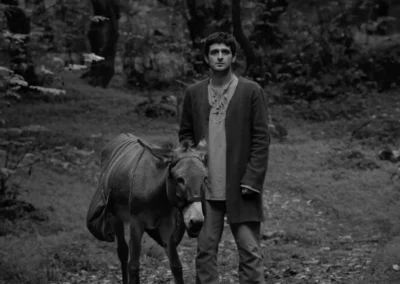

tell the wind too
by Sina Khani
Shahriar embarks on a three-day journey in nature with his loyal donkey, confronting his vulnerability, search for meaning, and isolation after his father’s death.
Synopsis
Shahriar, a rustic man, starts a journey of self-discovery after his father’s demise. He, along with his beloved donkey, goes to find a special place, finding solace and trouble on the way. Peculiar encounters caution him against going further into nature, but he decides to continue his journey at all costs.
tell the wind too
by Sina Khani
Shahriar embarks on a three-day journey in nature with his loyal donkey, confronting his vulnerability, search for meaning, and isolation after his father’s death.
Synopsis
Shahriar, a rustic man, starts a journey of self-discovery after his father’s demise. He, along with his beloved donkey, goes to find a special place, finding solace and trouble on the way. Peculiar encounters caution him against going further into nature, but he decides to continue his journey at all costs.
TELL THE WIND TOO
Iran, 2024 / 62′
a film by
Sina Khani
with
Naeem Salehi
Mohammadali Ebrahimi
Ali Rahimi
Behnam Aram
Mansour Aghajani
Ava Esmaeeli
Alireza Ahmadi
Parsa Eslami
Kamran Harati
Zahra Harati
| Written and Directed by | Sina Khani |
| Director of Photography | Farhad Talebinejad |
| Production Design | Erfan Yazdani |
| Costume Design | Mahrokh Soleimani |
| Editing | Esmaeel Monsef |
| Composer | Saeed Shahram |
| Sound | Ramin Abousedgh |
| Producer | Sina Ahmadkhani |
| Distribution | Alpha Film |

AWARDS
- Portoviejo Film Festival
Ecuador, 2025
BEST INTERNATIONAL EXPERIMENTALFEATURE FILM
Official Selections
- New York City Independent Film Festival
USA, 2025 - Portoviejo Film Festival
Ecuador, 2025 - Toronto International Nollywood Film Festival
Canada, 2025
The Director

Sina Khani
Biofilmography
Sina Khani (aka Sina Ahmadkhani), born in Tehran, Iran, is a filmmaker whose passion for storytelling and film blossomed during his studies at Sharif University of Technology. He made his directorial debut with a feature film set in Mazandaran, showcasing his stylized cinematography. His debut film’s themes delved into an existential discussion on loss and human folly.
Khani pursued a Master of Fine Arts (MFA) at Virginia Commonwealth University in Richmond, USA. Khani’s work seamlessly merges innovative cinematography with character-based narrative ingenuity.
Director statement
With a metaphoric language, I wanted to explore the character’s introspection in the story. The idea of “the night” expanded to explore Shahriar’s trauma and loss. Through Shahriar – a character who searches for meaning and refuses external values – I wanted to delve into an existential discussion on loss and human folly. There was extreme contrast between him and the world around him to emphasize his isolation, where absurdism manifests his inability to connect to the world.
The character’s journey stemmed from the alienation and absurdity of my life in Iran. Surrealism became a tool to depict how lost one can be in relation to the world, where beauty lies, and how redemption is experienced.
Shooting in black and white felt right, as I wanted to show the terror and beauty of nature. Depicting the tree trunks as the tall, black bars and capturing the true blackness of dark were some of the preferred aesthetic.















